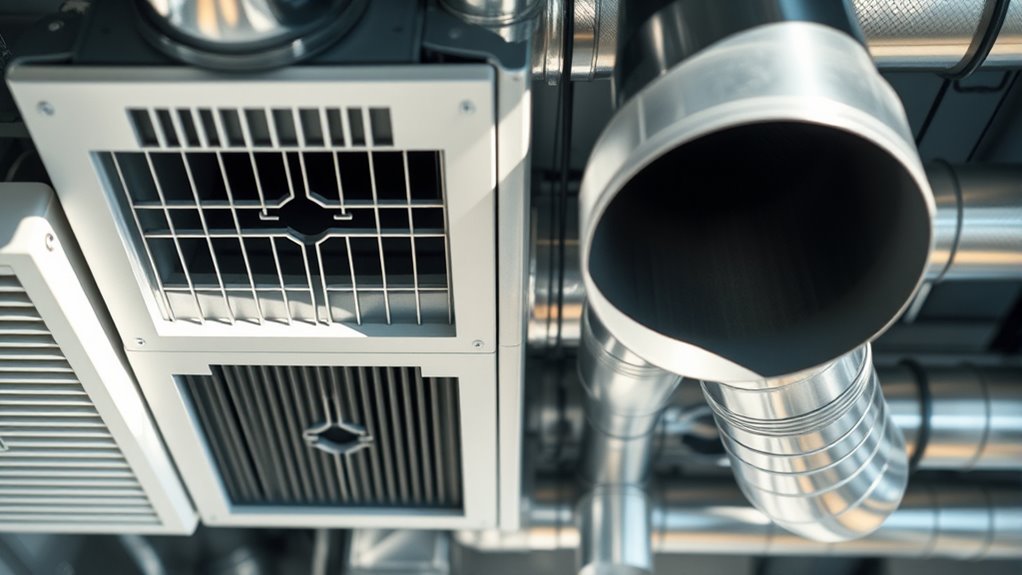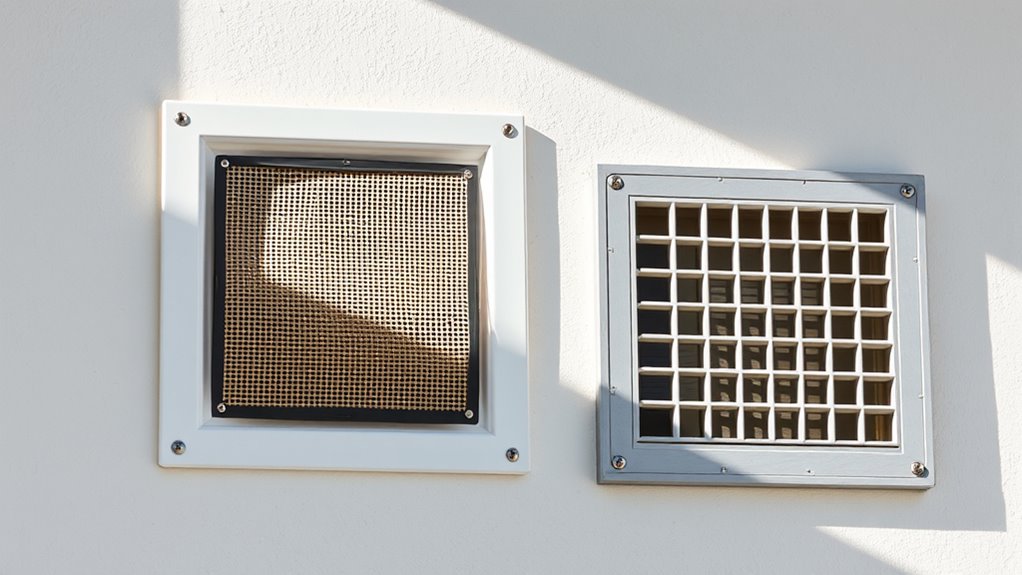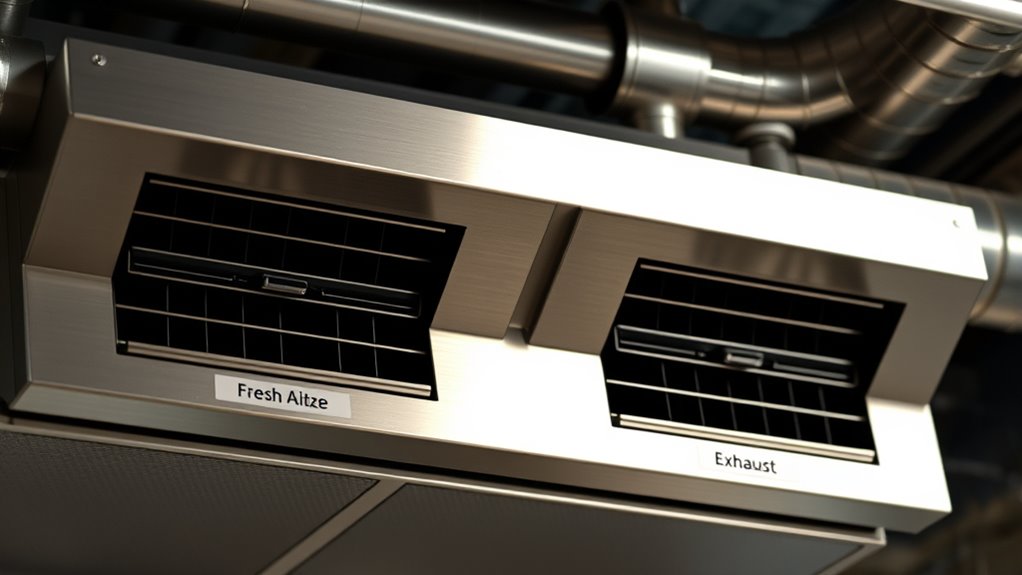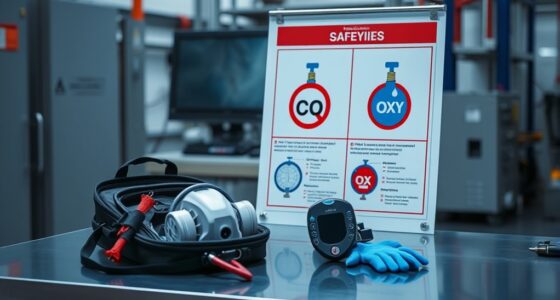A fresh air intake and exhaust calculator helps you balance airflow in your home’s ventilation system, ensuring you get enough fresh air without losing energy or causing humidity issues. These tools guide you in adjusting intake and exhaust rates, preventing stale air, pollutants, or mold buildup. Understanding how these calculations work lets you optimize your system for better air quality and comfort. Keep exploring, and you’ll gain practical tips to improve your home’s ventilation effectively.
Key Takeaways
- A fresh air intake calculator determines optimal outdoor air volume needed to maintain indoor air quality without over-ventilating.
- An exhaust calculator estimates the removal rate of indoor pollutants, humidity, and stale air to ensure effective air exchange.
- Properly balancing intake and exhaust rates prevents indoor air issues, like humidity buildup, odors, and pollutant accumulation.
- Accurate calculations depend on factors like space size, occupancy, and system specifics, critical for energy efficiency and health.
- Pros emphasize that understanding these calculators helps optimize ventilation, reduce energy waste, and promote healthier indoor environments.
Understanding the Basics of Home Ventilation

Understanding the basics of home ventilation is essential for maintaining good indoor air quality and energy efficiency. Proper ventilation ensures fresh air circulates throughout your home, removing pollutants, odors, and excess humidity. When airflow is balanced, you’ll notice improved indoor comfort, as temperatures stay stable and air feels fresher. Without adequate ventilation, indoor air can become stale, leading to health issues and discomfort. Ventilation systems work by exchanging indoor air with outdoor air, reducing contaminants and controlling humidity. Knowing how these systems operate helps you optimize their performance and make smarter decisions about air quality. Proper air exchange is critical for preventing the buildup of harmful gases like carbon monoxide, especially when operating a wood stove. Whether you’re upgrading an existing system or planning a new setup, understanding these essentials guarantees your home remains comfortable, healthy, and energy-efficient.
How Fresh Air Intake and Exhaust Systems Work Together

Your fresh air intake and exhaust systems need to work in harmony to maintain balanced airflow. When they function together properly, they prevent stale air and reduce the risk of contaminant build-up. This coordination keeps your home healthy and comfortable. Proper air quality management is essential for ensuring that your ventilation system effectively improves indoor air conditions.
Balanced Airflow Dynamics
When fresh air intake and exhaust systems work in harmony, they create a balanced airflow that maintains indoor air quality and comfort. This balance ensures ideal airflow efficiency and prevents issues like stale air or pressure imbalances. Proper system calibration is essential to achieve this harmony, adjusting intake and exhaust rates for smooth operation. Additionally, understanding air exchange rates is crucial for optimizing system performance and ensuring adequate ventilation.
Preventing Contaminant Build-up
Maintaining proper airflow balance between fresh air intake and exhaust systems plays a key role in preventing the buildup of contaminants indoors. When these systems work together effectively, they help improve air quality by continuously removing stale air, pollutants, and excess moisture. Proper exhaust removes indoor odors, airborne particles, and moisture that can lead to mold growth, while fresh air intake supplies clean, filtered air to dilute indoor pollutants. Without balanced airflow, contaminants can accumulate, reducing air quality and increasing health risks. Moisture control is especially vital because excess humidity fosters mold and bacteria growth. By ensuring your ventilation system is correctly calibrated, you create a healthier indoor environment, reduce the risk of contaminant build-up, and promote better moisture management. Additionally, advances in AI technology enhance the ability to monitor and optimize ventilation systems for better air quality control.
The Role of Calculators in Designing Ventilation Systems

Calculators play a crucial role in designing effective ventilation systems by providing precise calculations for airflow, pressure, and capacity requirements. With accurate data, you can optimize ventilation efficiency, ensuring spaces are properly ventilated without wasting energy. The accuracy of these calculators directly impacts system performance; even small errors can lead to inadequate fresh air intake or excessive exhaust, affecting air quality and energy costs. By relying on these tools, you can determine the right balance between intake and exhaust, tailoring your system to the specific needs of your space. This precision helps prevent over- or under-ventilation, saving you money and enhancing indoor air quality. Additionally, understanding the horsepower of electric dirt bikes can inspire innovative applications of electric power in ventilation systems, such as energy-efficient motor designs. In short, calculators are essential for creating reliable, efficient ventilation solutions that meet your unique requirements.
Key Factors Influencing Fresh Air and Exhaust Balance

Accurate calculations are only part of designing a balanced ventilation system; understanding the key factors that influence fresh air intake and exhaust is equally important. These factors impact airflow efficiency and guarantee your system operates effectively. Incorporating digital literacy into your home’s ventilation knowledge can help you better understand and optimize system performance.
Common Mistakes Made When Using Ventilation Calculators

Many users make the mistake of entering incorrect assumptions in their inputs, which can lead to inaccurate results. Overlooking system specifics, like ductwork or fan capacity, also skews the calculations. Being precise and considering all relevant details is essential for reliable ventilation planning. Additionally, understanding proper ventilation system design can significantly improve the accuracy of your calculations.
Incorrect Assumptions in Inputs
One common mistake is making incorrect assumptions about the space’s volume or occupancy, which can lead to inaccurate ventilation calculations. These errors directly impact air quality and energy efficiency. To avoid this:
- Overestimating or underestimating the number of occupants skews ventilation needs, affecting air quality.
- Using generic or outdated space dimensions can result in inefficient airflow, wasting energy.
- Ignoring real-time usage patterns, like peak occupancy, leads to inadequate ventilation during critical periods.
- Failing to account for Vetted – Mother Baby Kids products and their specific needs can also cause miscalculations in ventilation requirements for sensitive environments.
Getting these inputs right ensures your system maintains healthy indoor air quality without unnecessary energy consumption. Accurate assumptions help balance fresh air intake and exhaust, optimizing both comfort and efficiency. Always verify your data for reliable, effective ventilation performance.
Overlooking System Specifics
When using ventilation calculators, overlooking specific system details can lead to significant errors in your results. Failing to factor in your system’s unique design, such as duct layout, fan capacity, or existing ventilation components, hampers accurate airflow optimization. These details directly impact ventilation efficiency, and ignoring them can cause over- or underestimations of required airflow. Misjudging system specifics may result in inadequate fresh air intake or poor exhaust performance, compromising air quality and energy use. To get reliable results, you need to input precise system parameters and understand how each element influences airflow. Neglecting these specifics limits your ability to optimize ventilation effectively, potentially leading to inefficient operation and unnecessary costs. Always tailor your calculations to your system’s actual setup for best outcomes. Additionally, understanding supermarket hours can aid in planning maintenance or upgrades to your ventilation system during off-peak times.
Tips for Interpreting and Applying Calculator Results

Interpreting the results from your fresh air intake vs. exhaust calculator requires careful attention to the specific values and their implications. First, focus on the balance between intake and exhaust to guarantee ideal indoor air quality—improper ratios can lead to stale air or excess humidity. Second, compare your calculated airflow rates with recommended standards to identify if adjustments are needed. Third, remember that consistent filter maintenance is vital; even the best system can underperform if filters are dirty. Proper interpretation helps you maximize ventilation, reduce indoor pollutants, and maintain healthy air quality. Use the calculator as a guide, but always consider real-world factors like filter condition and system efficiency for the best results. Additionally, understanding home security systems can help you protect your property while optimizing ventilation and air quality.
Why Knowledge of These Tools Matters for a Healthier Home

Understanding how to use fresh air intake and exhaust tools empowers you to create a healthier home environment. Knowing how these tools impact air quality and energy efficiency helps you make smarter decisions. Proper use guarantees fresh air circulates without wasting energy, reducing indoor pollutants and allergens. It also helps prevent issues like mold growth and stale air. To illustrate, consider this table:
| Benefit | Effect on Air Quality | Effect on Energy Efficiency |
|---|---|---|
| Improved ventilation | Removes indoor pollutants | Lowers energy costs |
| Balanced airflow | Prevents stale air | Maintains comfort levels |
| Proper tool use | Reduces allergens | Saves on heating/cooling |
Mastering these tools makes your home healthier, more comfortable, and cost-efficient.
Frequently Asked Questions
How Often Should I Recalculate My Home’s Ventilation Needs?
You should recalculate your home’s ventilation needs whenever there’s a significant change, like renovations, adding new rooms, or changes in occupancy. Staying updated ensures you meet current ventilation standards and maintain calculation accuracy. Regular checks—at least once every few years—help you catch any issues early and keep indoor air quality ideal. This proactive approach guarantees your system adapts to your home’s evolving needs, promoting healthier living conditions.
Can Incorrect Calculations Lead to Poor Indoor Air Quality?
Incorrect calculations can definitely harm your indoor air quality and ventilation efficiency. When you misjudge your home’s ventilation needs, it may lead to inadequate fresh air intake or exhaust, trapping pollutants and moisture inside. This buildup can cause health issues and discomfort. To maintain ideal air quality, always double-check your calculations, update them regularly, and make sure your ventilation system properly balances airflow, keeping your indoor environment fresh and healthy.
Are There Specific Tools Recommended for DIY Ventilation Calculations?
Did you know that improper ventilation can increase indoor pollutants by up to 60%? For DIY ventilation calculations, you should use reliable measurement tools like an anemometer for airflow and a CO2 meter to assess air quality. These tools help you achieve balanced ventilation, ensuring fresh air intake matches exhaust, which is vital for healthy indoor environments. Accurate measurements empower you to optimize your ventilation system effectively.
How Do Climate Variations Affect Fresh Air and Exhaust Requirements?
Climate variations are crucial impact your fresh air and exhaust needs because they influence air exchange rates. In colder climates, you might need more exhaust to remove humidity and pollutants, while in warmer areas, fresh air intake should prioritize cooling and ventilation. You should adjust your system based on the climate impact, ensuring proper air exchange to maintain indoor air quality and comfort year-round. Properly balancing these factors is significantly for effective ventilation.
What Signs Indicate My Ventilation System Needs Adjustment?
Your ventilation system may be crying out for help if you notice stuffy odors, uneven airflow, or persistent allergies. These signs point to an airflow imbalance, meaning fresh air isn’t circulating properly. Don’t forget, regular filter maintenance keeps airflow smooth and prevents blockages. If issues persist despite these steps, it’s time to adjust your system, ensuring it breathes as freely as you do.
Conclusion
Understanding how fresh air intake and exhaust work together might seem complicated at first, but with the right calculator, you’ll make smarter choices for your home’s ventilation. Don’t worry if it feels overwhelming—practice and guidance make perfect. By learning these tools, you’ll create a healthier, more comfortable living space, and that’s worth the effort. So, embrace the process—you’ll breathe easier knowing you’ve got it under control.









